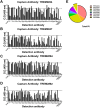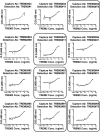Preclinical development of an immunoassay for the detection of TREM2: a new biomarker for Alzheimer's disease
- PMID: 40691204
- PMCID: PMC12280022
- DOI: 10.1038/s41598-025-09262-x
Preclinical development of an immunoassay for the detection of TREM2: a new biomarker for Alzheimer's disease
Abstract
Alzheimer's disease (AD) is a neurodegenerative disorder characterized by the accumulation of amyloid-β (Aβ) plaques and neurofibrillary tangles composed of hyperphosphorylated tau protein. The combination of biomarkers is crucial for AD diagnosis. The triggering receptor expressed on myeloid cells 2 (TREM2), a receptor expressed on microglia, is important in AD pathogenesis. Impairment of TREM2 function aggravates the toxic effects of amyloid plaques, and its activation has been shown to reduce Aβ burden and memory deficits. Increased levels of soluble TREM2 (sTREM2) in blood and cerebrospinal fluid is associated with AD. Therefore, TREM2 could serve as a non-invasive biomarker for AD. In this study, we developed a preclinical immunoassay to detect TREM2 for AD diagnosis. Highly sensitive and specific TREM2 antibodies were produced using the hybridoma technique. The three optimized immunoassays exhibited lower limit of quantitation (LLOQ) of 0.474, 0.807, and 0.415 ng/mL, respectively. These preclinical immunoassays showed high sensitivity and specificity. The sandwich enzyme-linked immunosorbent assay (ELISA) could potentially be used for AD diagnosis.
Keywords: Alzheimer’s disease; Biomarker; Detection; TREM2.
© 2025. The Author(s).
Conflict of interest statement
Declarations. Competing interests: The authors declare no competing interests. Ethical approval: All experiments were performed in accordance with ARRIVE guidelines. The animal study was approved by the Animal Ethics Committee of the Shenzhen Bay Laboratory (agreement code: AECZC202101, December 2021).
Figures








Similar articles
-
Higher plasma soluble TREM2 correlates with reduced cerebral tau accumulation in Alzheimer's disease.Mol Psychiatry. 2025 Sep;30(9):3988-3997. doi: 10.1038/s41380-025-02976-4. Epub 2025 Apr 1. Mol Psychiatry. 2025. PMID: 40169800
-
Variants in the MS4A cluster interact with soluble TREM2 expression on biomarkers of neuropathology.Mol Neurodegener. 2024 May 18;19(1):41. doi: 10.1186/s13024-024-00727-7. Mol Neurodegener. 2024. PMID: 38760857 Free PMC article.
-
CSF tau and the CSF tau/ABeta ratio for the diagnosis of Alzheimer's disease dementia and other dementias in people with mild cognitive impairment (MCI).Cochrane Database Syst Rev. 2017 Mar 22;3(3):CD010803. doi: 10.1002/14651858.CD010803.pub2. Cochrane Database Syst Rev. 2017. PMID: 28328043 Free PMC article.
-
The impact of kidney function on Alzheimer's disease blood biomarkers: implications for predicting amyloid-β positivity.Alzheimers Res Ther. 2025 Feb 19;17(1):48. doi: 10.1186/s13195-025-01692-z. Alzheimers Res Ther. 2025. PMID: 39972340 Free PMC article.
-
Selegiline for Alzheimer's disease.Cochrane Database Syst Rev. 2003;(1):CD000442. doi: 10.1002/14651858.CD000442. Cochrane Database Syst Rev. 2003. PMID: 12535396
References
-
- Dementia. 2023: World Health Organization.
MeSH terms
Substances
LinkOut - more resources
Full Text Sources
Medical

